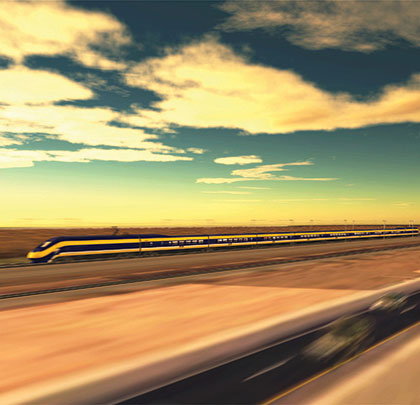The California High Speed Rail Authority broke ground in January on the nation’s first high-speed rail system with a focus on the fact that some of the world’s most advanced and cleanest diesel equipment will be used to construct the historic project.
“While there is a debate on the merits of the high-speed rail project in general, one thing that is not in debate is the readiness of the most advanced construction machines and equipment to build the project,” says Allen Schaeffer, the executive director of the Diesel Technology Forum.
“It is fitting that a project of this size will be built with the latest generation of advanced clean diesel technology. This massive project is being done with the most advanced and sustainable green construction practices, which is why the latest clean diesel engines and equipment that meet the nation’s most stringent environmental standards—known as Tier 4—are the technology of choice. No other fuel or technology can match the combination of power, efficiency, performance, and now near-zero emissions of these machines.
TIER 4 MEANS CLEANER AIR
“The standards, established by both the California Air Resources Board and the U.S. Environmental Protection Agency, have been in effect since 2014 and will deliver significant air quality benefits to the communities surrounding the project and result in a 90 percent reduction in particulate matter and oxides of nitrogen, an ozone forming compound,” says Schaeffer.
The new generation Tier 4 clean diesel technology achieves a substantial reduction in emissions of particulate matter and oxides of nitrogen (NOx) from engines deployed on off-road equipment, including construction equipment manufactured beginning in 2014. According to U.S. EPA estimates, by 2030 the national benefits of Tier 4 engines will include:
- Reduce nitrogen oxide (NOx) emissions by 1 million tons or 82 percent
- Reduce particle matter (PM2.5) emissions by 90 percent
- Reduce sulfur dioxide (SO2) emissions by 99.7 percent
GREEN CONSTRUCTION
Phase 1 of the high-speed rail project, stretching from San Francisco to Los Angeles/Anaheim, will cost an estimated $68 billion and be in operation in 2028. Phase 2 will be constructed later. It will add extensions to San Diego and Sacramento and complete the 800-mile statewide system. Construction on parts of the system are already underway along a 29-mile route from Madera to Fresno, with clean diesel powered equipment conducting demolition, drilling, and viaduct work, as well as water, sewer, and storm drain relocation and general excavation. Diesel engines power more than two-thirds of all construction equipment, and power all of the heavy cranes, crawlers, and excavators that will be the workhorses used to build the high-speed rail network.
In November 2014, the High-Speed Rail Alliance and the U.S. Environmental Protection Agency recognized clean diesel technology as a key part of the Green Construction partnership.
“Tier 4 equipment will not only deliver clean air benefits to local communities, but also the potential for significant fuel savings for contractors that translates into greenhouse gas emission reductions,” says Schaeffer. “The Tier 4 rules are the latest milestone on the clean diesel pathway established by the Air Resources Board and the U.S. Environmental Protection Agency. We are proud to represent the leaders in manufacturing of clean diesel construction engines, machines, and equipment, including Caterpillar, Cummins, CNH Industrial, Deere, Isuzu, MTU America, Volvo, and Yanmar.”

CLEAN DIESEL TECHNOLOGY
According to the Diesel Technology Forum, clean diesel technology is better able than ever before to help users improve efficiency and minimize environmental impacts through cleaner and more efficient methods of transporting freight and people, mining resources, constructing buildings, growing crops, and providing power. By incorporating clean diesel technology in their operations, supply chains or personal lives; businesses, governments and individuals can maintain or improve performance with reduced impact on the world around them.
For diesel power users, clean diesel technology can minimize environmental costs and enhance operational sustainability through fuel use, vehicle/equipment efficiency, and the number of vehicle miles traveled. It can also contribute to sustainability by enhancing economic and social security as a reliable source of clean backup power. ■
For More Information:
The Diesel Technology Forum is a non-profit national organization dedicated to raising awareness about the importance of diesel engines, fuel, and technology. Forum members are leaders in clean diesel technology and represent the three key elements of the modern clean-diesel system: advanced engines, vehicles and equipment, cleaner diesel fuel and emissions-control systems. For more information, visit www.dieselforum.org.
_________________________________________________________________________
Modern Contractor Solutions, February 2015
Did you enjoy this article?
Subscribe to the FREE Digital Edition of Modern Contractor Solutions magazine.



